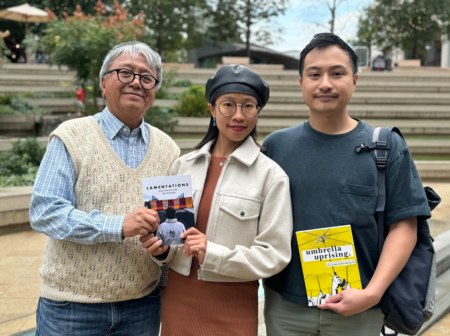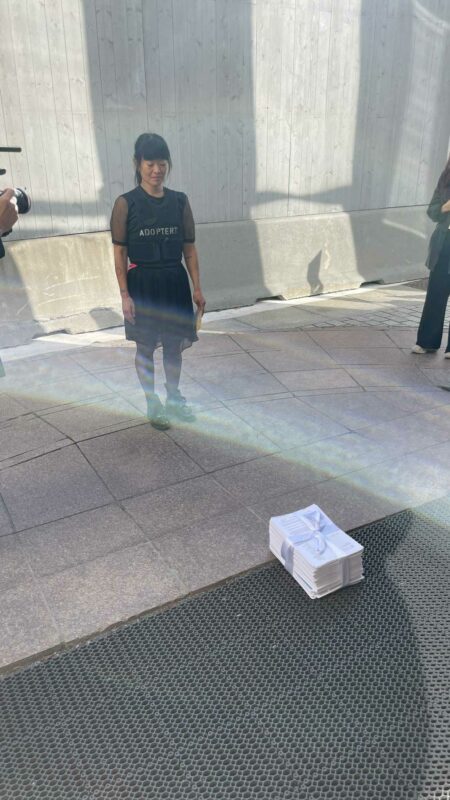Photo: Knut Bry
Four footballers warm up beneath floodlights, skipping around the white chalk lines of the pitch and stretching their hips in wide lunges. One of the players faces the stands, leading a call-and-response with the crowd, eventually including his teammates in the cheers. Then, the whistle blows.
The crowd falls quiet, watching Kevin Haugan, Jakub Mędrzycki, Mikkel Are Olsenlund, and Kristian Vindenes slide-tackle invisible opponents, weaving between each other to gain possession of the ball and pass quickly. The lights fade to black. Then, the stage lights illuminate a tableau of men, jaws unhinged in silent screams, celebrating an unseen goal. The fade out repeats several times, featuring the men frozen in various snapshots from the game, like a post-match highlight reel.
This isn’t an ordinary football match. This is A Dance Tribute to the Art of Football, performed by the Jo Strømgren Kompani on 29 June 2025. The Sunday matinee was full of tourists and families of all ages, all gathered to watch the 30-minute condensed version of Jo Strømgren’s acclaimed piece. The intimate Scene 2 stage transformed into a small stadium, with seats filled just under the 440-person capacity.
Originally choreographed in 1997 as a 55-minute evening-length work, Strømgren was inspired by the juxtaposition of “common sports” and “eloquent arts,” including class dynamics and homoeroticism. Football and other traditionally male-dominated sports provide a safe space for male intimacy protected by the guise of the game as a separate world from reality. In a theatrical setting, Strømgren can strip back the layers of brotherhood and competition to expose the closeness and vulnerabilities behind the dazzling lights on the pitch.
After about 20 minutes of high intensity gameplay and audience engagement, the dance ends as the game does: in the locker room. At first, the mood is light and comical as the players undress. At one point, Haugan wears all four players’ shorts, and Vindenes becomes entangled in the eight kit sleeves. Then, the mood suddenly takes a more serious tone. Each player drops their briefs one at a time, staring at each other to ensure they all join in the post-match ritual. The lights fade, then the players are dimly illuminated only by dappled light from above, mimicking the spray of a communal shower room. The men move elegantly, arms slowly raising with a balletic carriage, so smooth it seems as if water is actually running down their bare backs. They face upstage, maintaining decorum in the shadows while being intently observed by the silent audience just behind them.
The mood in the small theatre is almost reverent, as if we were in a church rather than an opera house. The shower scene explores the quiet intimacy of the locker room in contrast to the riotous nature of the game itself. By encouraging audience participation as a cheering crowd earlier on, the dynamic between onlooker and footballer begins to feel voyeuristic, enhancing the sense of vulnerability and exposure for all parties involved.
Like Strømgren, artists across disciplines continue to be inspired by this homoerotic relationship between players, sometimes in the exposed view of the pitch and other times in the privacy of a locker room. British visual artist JJ Guest’s 2023 presented his exhibition “The Other Team” at Tottenham Hotspur Stadium’s OOF Gallery in London. Guest’s frustration with the double standards of facing homophobia while growing up queer in Birmingham while watching footballers kiss on the pitch on the world’s stage inspired the work.
The exhibition features a replica communal bathtub with water-activated portraits and a life-size sculpture of Gary Neville and Paul Scholes kissing during a match after Scholes scored a last-minute goal. Footballers share a deep, embodied connection, spending hours learning how to move in perfect coordination and training their bodies to perform at their best. This connection also extends beyond the physical, with an incomparable emotional bond forming between players who see each other every day, through highs and lows. In an interview for the Design Museum in London, Guest says, “I remember questioning why it was okay for Gary Neville and Paul Scholes to embrace each other, so openly (and open-mouthed), but I have to keep that sort of thing hidden and behind closed doors? There’s this hypocrisy of what’s acceptable on and off the pitch, this protection that wearing a football shirt provides.”

Comedy also acts as a layer of protection for open expression of male affection. Olsenlund and Mędrzycki bring humour through audience interaction and physical comedy. They master the art of a post-goal scream, with their faces expressing the fierce, extravagant triumph of footballers sliding on their knees after scoring. They exaggerate the performance of masculinity among players, at one point stripping down to their socks and briefs, standing mere centimetres apart from each other, then slowly expanding their diaphragms until their bare bellies touch.
Vindenes runs around the stage with the oddly upright, distinctive quality of Clésio Moreira dos Santos, a Portuguese referee known for his unique flair and flamboyant yellow card presentation. Dos Santos cites the original camp referee, Jorge José Emiliano dos Santos (no relation), one of Brazil’s first openly gay referees, as inspiration for his unique style. Football provided a stage for both men to perform their roles with unabashed enthusiasm. However, despite football allowing for men (and women, in a different context) to exercise more freedom of affectionate expression, there are very few openly gay male footballers or referees. Thomas Berling represented Norway as a U19 player, but he retired from the game at just 21 years old in 2000, citing homophobia as a major factor into his decision.
30 years on, Strømgren’s work has been on tour every year since 2009. Other than the 1930 ballet The Golden Age—featuring a Soviet football team with music composed by football-fanatic composer Dmitri Shostakovich—A Dance Tribute to the Art of Football is a trailblazing intersection between art and athletics. This performance kickstarted a trend in contemporary dance interpretations of the globally beloved sport, from Ballet de Lorraine’s 2011 camp dance battle Discofoot to Nadine Bommer’s 2015 all-female, machismo Invisi’BALL. With the Women’s European Championship in the spotlight this summer, the Opera House is capitalising on the public appeal and football fervour, with reduced tickets just 150 kr for adults.
The dancers excel in their interpretations of players, blending footballer idiosyncrasies (knee-sliding, hip-thrusting goal celebrations and mid-air headers with full body contractions) with the athleticism of contemporary dance. The condensed piece does not detract from the overall dynamics of the work, starting with the humble beginnings of football, building to the climax of a game and ending with a reflective insight into the privacy of the locker room.
Strømgren’s love letter to the beautiful game subtly yet strongly comments on male sexuality and football’s enduring popularity. This show is for football fans and dance aficionados alike, with breathtakingly buoyant leaps and comedic groin scratching to keep the crowd on their toes.
A Dance Tribute to the Art of Football is on at The Norwegian National Opera & Ballet (Oslo Opera House) from 27 June-20 July.







